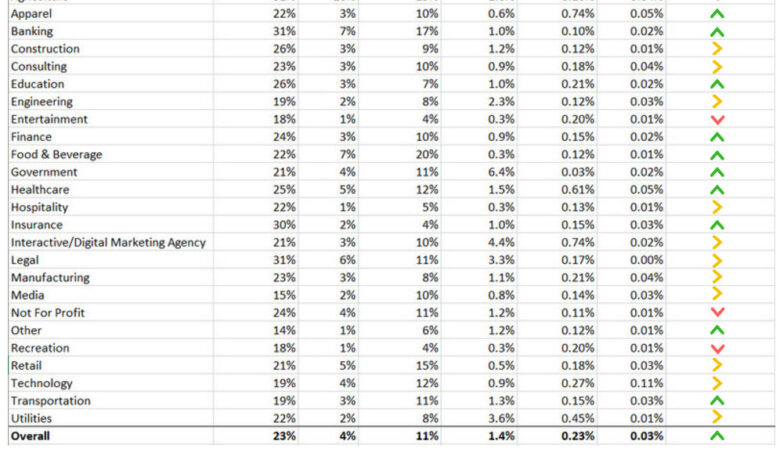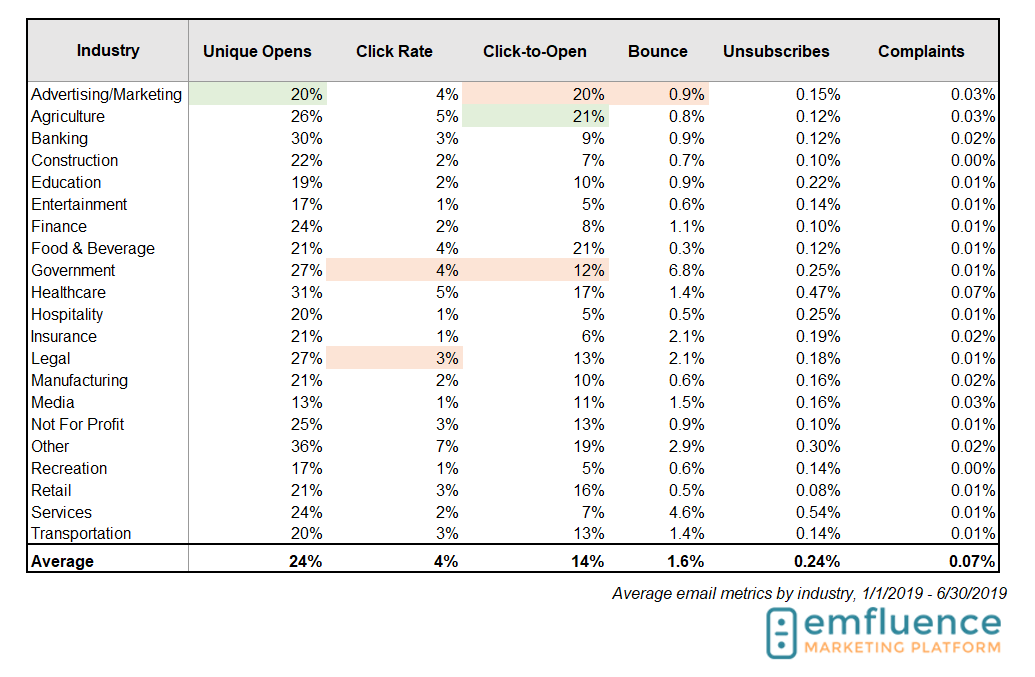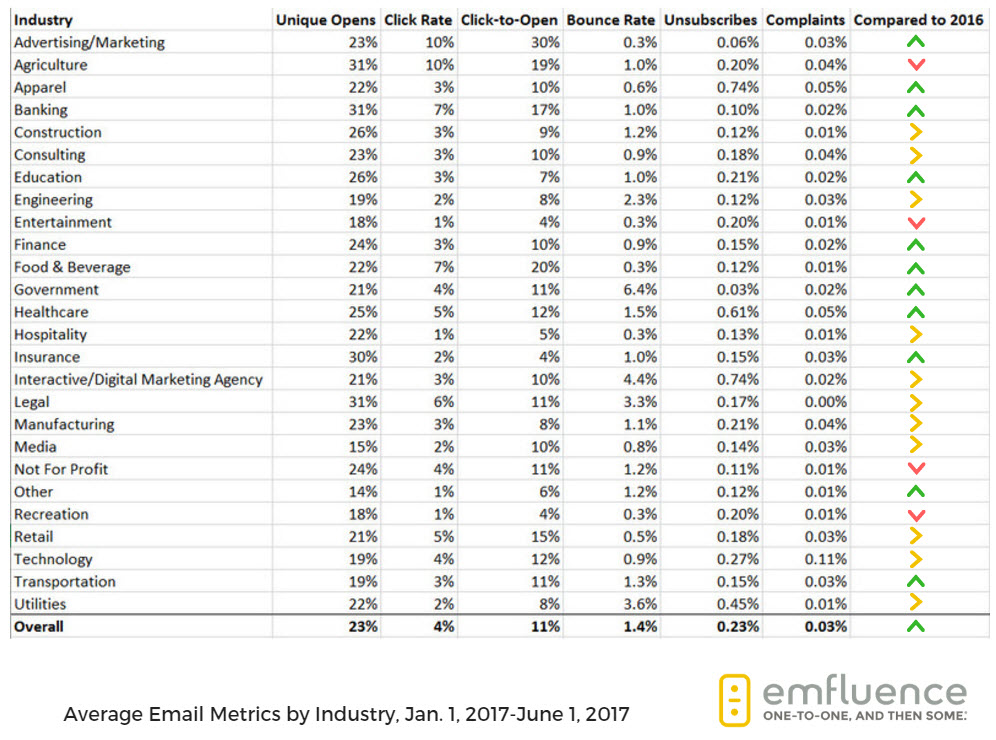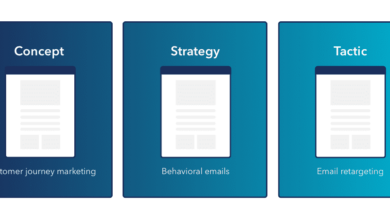
Email Marketing Benchmarks Your Guide to Success
Email marketing benchmarks provide a crucial roadmap for success in the digital age. Understanding these benchmarks allows you to gauge your performance against industry standards, identify areas for improvement, and ultimately, optimize your campaigns for maximum impact. This comprehensive guide dives deep into email marketing benchmarks, exploring everything from defining them to analyzing trends over time.
We’ll cover key metrics like open rates, click-through rates, and conversion rates, and examine how factors like email design, subject lines, and list segmentation influence your results. Learning these benchmarks empowers you to craft targeted, effective email campaigns that drive real results.
Defining Email Marketing Benchmarks
Email marketing benchmarks are crucial for understanding how your campaigns perform against industry averages. They provide a framework for evaluating your success and identifying areas for improvement. They’re not arbitrary numbers; they’re derived from data collected from numerous successful email marketing campaigns. Knowing these benchmarks helps you optimize your strategies and ensure your campaigns are as effective as possible.A strong understanding of email marketing benchmarks allows you to compare your results against industry standards, identifying both strengths and weaknesses in your approach.
This comparison enables data-driven decision-making, helping you to fine-tune your email strategies for maximum impact. By consistently measuring against benchmarks, you gain a clear picture of your performance, which facilitates continuous improvement.
Defining Email Marketing Benchmarks
Email marketing benchmarks are quantitative metrics used to measure the effectiveness of email campaigns. They represent average performance across various email marketing campaigns. These benchmarks serve as valuable standards for evaluating campaign success and identifying areas for improvement.
Importance of Using Email Marketing Benchmarks
Benchmarking allows for a comparative analysis of your email campaign performance against industry standards. It provides valuable insights into your email strategy’s effectiveness and enables data-driven adjustments to improve campaign results. By understanding the benchmarks, you can identify areas for improvement and optimize your campaigns to maximize engagement and conversions.
Key Factors Influencing Benchmark Values
Various factors influence email marketing benchmark values, including industry, target audience, campaign type, and the overall marketing strategy. Industry standards differ based on the nature of the products or services being promoted. Different target audiences respond to various types of emails, impacting open and click-through rates. The complexity and type of campaign, including promotional or informational content, can also influence benchmark values.
Types of Email Marketing Benchmarks
Understanding the different types of email marketing benchmarks is crucial for a comprehensive evaluation of campaign performance. This allows for a focused approach to improvement and optimization.
| Benchmark Type | Description | Typical Range (Examples) |
|---|---|---|
| Open Rate | Percentage of recipients who opened the email. | 15-30% (varies widely based on industry and audience) |
| Click-Through Rate (CTR) | Percentage of recipients who clicked on a link within the email. | 2-5% (highly dependent on subject line and email content) |
| Conversion Rate | Percentage of recipients who completed a desired action (e.g., making a purchase). | 1-5% (influenced by the offer, the call to action, and the product or service being promoted) |
| Bounce Rate | Percentage of emails that were not delivered to the recipient’s inbox. | 0.5-5% (can be affected by poor email list management and spam filters) |
| Spam Complaints | Percentage of recipients who marked the email as spam. | 0.1-0.5% (reflects the quality of the email content and sender reputation) |
Industry-Specific Benchmarks
Email marketing isn’t a one-size-fits-all strategy. Different industries have unique needs and preferences, which directly impact email performance. Understanding these industry-specific nuances allows marketers to tailor their campaigns for optimal results. This means crafting emails that resonate with specific customer segments and deliver value relevant to their industry.Knowing what constitutes a good open rate or click-through rate in one sector might be completely different in another.
A high-tech company targeting early adopters might have vastly different email engagement metrics compared to a traditional retailer focused on broad customer appeal. This crucial insight lets marketers avoid generic approaches and focus on tailored strategies that yield better results.
Retail Email Marketing Benchmarks
Retail email marketing campaigns often focus on promotions, new arrivals, and seasonal sales. Understanding how these factors affect open and click-through rates is vital for optimizing strategies. Retailers typically rely on visually appealing emails with clear calls to action to drive sales. This frequently includes high-quality product images, concise descriptions, and strong value propositions.
SaaS Email Marketing Benchmarks
SaaS companies often use email marketing for lead nurturing, onboarding new customers, and promoting upselling/cross-selling opportunities. Their emails frequently focus on providing valuable content, demonstrating product benefits, and fostering long-term customer relationships. This emphasis on education and customer support translates into email strategies that are quite different from those used in retail.
Healthcare Email Marketing Benchmarks
Healthcare email marketing is highly regulated and requires adherence to strict privacy and compliance standards. Emails often include informative content about health updates, new services, or upcoming events. They must prioritize building trust and demonstrating expertise in the healthcare sector. Email marketing for healthcare organizations must prioritize patient safety and security, and therefore must be designed with this in mind.
Comparison of Retail and SaaS Open Rates
| Industry | Average Open Rate | Average Click-Through Rate |
|---|---|---|
| Retail | 18-22% | 3-5% |
| SaaS | 15-20% | 2-4% |
This table demonstrates a slight difference in open rates between retail and SaaS industries. While both have similar click-through rates, there is a difference in the overall engagement.
The average open rate for retail emails tends to be slightly higher than that of SaaS emails. This could be attributed to the nature of retail promotions and the focus on immediate purchase incentives. SaaS emails, on the other hand, prioritize nurturing leads and building long-term relationships. Therefore, the emphasis isn’t always on immediate action. This comparison underscores the importance of tailoring email campaigns to specific industry needs and expectations.
Key Metrics for Evaluation
Email marketing, a powerful tool for businesses, demands meticulous tracking and analysis to optimize campaigns. Understanding key performance indicators (KPIs) is crucial for gauging the effectiveness of your efforts and identifying areas for improvement. This section dives into the essential metrics used to assess email marketing success, highlighting the importance of open rates, click-through rates, conversion rates, bounce rates, and unsubscribe rates.Email campaigns are rarely successful without comprehensive data analysis.
Tracking these metrics allows businesses to make data-driven decisions, ultimately leading to increased engagement and conversions. Analyzing these metrics over time helps identify trends and optimize future campaigns for better results.
Open Rates
Open rates represent the percentage of recipients who opened your email. This metric provides insights into the effectiveness of your subject lines and sender reputation. A high open rate suggests your subject lines are compelling and your emails are reaching the intended audience. A low open rate may indicate the need for better subject line writing or improvements in your sender reputation.
Click-Through Rates
Click-through rates (CTR) measure the percentage of recipients who clicked on a link within your email. A higher CTR indicates that your email content is engaging and persuasive, encouraging recipients to take action. This metric is critical for assessing the effectiveness of your call-to-actions (CTAs) and the overall value proposition of your email. Tracking CTRs across different segments of your audience allows you to identify areas for improvement and personalize your future campaigns.
Conversion Rates
Conversion rates represent the percentage of recipients who completed a desired action, such as making a purchase or filling out a form. This is a crucial metric for measuring the ultimate success of your email marketing campaigns. High conversion rates indicate effective email marketing strategies, while low conversion rates might point to issues with the email content, landing pages, or overall customer journey.
Bounce Rates
Bounce rates measure the percentage of emails that were returned undeliverable. High bounce rates can be caused by incorrect email addresses, full inboxes, or server issues. Monitoring bounce rates is essential to ensure your emails reach the intended recipients. Regularly checking and addressing bounce rates can improve deliverability and maintain a healthy email list.
Unsubscribe Rates
Unsubscribe rates represent the percentage of recipients who opted out of receiving future emails. A high unsubscribe rate might indicate dissatisfaction with your content, irrelevant emails, or excessive communication. Analyzing unsubscribe rates can help identify areas where you can improve the quality and relevance of your emails. This is an important metric to track, as a high rate can damage your sender reputation and email deliverability.
Calculation Methods for Email Marketing Metrics
| Metric | Calculation Method |
|---|---|
| Open Rate | (Number of Opened Emails / Number of Delivered Emails) – 100 |
| Click-Through Rate (CTR) | (Number of Clicks / Number of Opened Emails) – 100 |
| Conversion Rate | (Number of Conversions / Number of Clicks) – 100 |
| Bounce Rate | (Number of Bounced Emails / Number of Sent Emails) – 100 |
| Unsubscribe Rate | (Number of Unsubscribes / Number of Delivered Emails) – 100 |
Factors Affecting Email Marketing Performance
Email marketing, despite its enduring popularity, is a dynamic field. Success hinges not just on crafting compelling messages, but also on a multitude of factors that influence campaign performance. Understanding these factors allows marketers to optimize their strategies and achieve better results, ultimately leading to higher ROI.Email marketing campaign performance is a complex interplay of various factors. From the initial subject line to the recipient’s engagement with the content, each element plays a critical role in determining the overall success of a campaign.
Understanding these nuances is key to interpreting benchmarks and tailoring strategies for optimal results.
Subject Line Impact on Open Rates
Subject lines are the first impression a recipient gets. A captivating subject line can entice recipients to open the email, while a weak one can lead to it being ignored. The effectiveness of a subject line is influenced by several factors, including its length, clarity, personalization, and the use of urgency or curiosity.
Understanding email marketing benchmarks is key, but sometimes you need a deeper dive. That’s where subject matter experts come in handy – subject matter experts can provide valuable insights on optimal strategies for email campaigns. Ultimately, these benchmarks, with expert guidance, can significantly improve your email marketing performance.
| Subject Line | Description | Estimated Open Rate |
|---|---|---|
| Clear and Concise | Clearly states the email’s purpose | 15-20% |
| Intriguing Question | Asks a question to pique recipient interest | 18-25% |
| Personalized Subject Line | Includes the recipient’s name or other personalized information | 20-30% |
| Urgent or Time-Sensitive | Creates a sense of urgency to encourage immediate action | 25-35% |
| Irrelevant or Unclear | Doesn’t clearly state the email’s purpose | 5-10% |
This table provides a glimpse into how different subject lines can influence open rates. Note that these are estimated ranges and actual results can vary depending on several factors, including the email list segmentation and other factors affecting email performance.
Email Content and Engagement
The content of the email itself is crucial for driving engagement. Clear, concise, and well-structured content that aligns with the recipient’s interests is vital for achieving high open and click-through rates.Email content, including its layout, design, and the call-to-action (CTA) elements, directly affects how recipients interact with the email. A visually appealing and well-organized email often leads to higher engagement and conversions.
Sender Reputation and Email List Segmentation
Sender reputation significantly impacts deliverability and open rates. A strong sender reputation, built over time through consistent, relevant communication, allows emails to reach the inbox rather than the spam folder.Email list segmentation is another key factor. By segmenting recipients based on their interests, behaviors, and demographics, marketers can tailor email content for maximum relevance and impact. This personalization leads to higher engagement rates and improved campaign performance.
Targeted messages resonate more effectively with recipients, driving higher open and click-through rates, and improving overall campaign ROI. For instance, a promotional email about hiking gear might be more engaging for recipients who have expressed interest in outdoor activities compared to those with no interest.
Best Practices for Achieving Optimal Results: Email Marketing Benchmarks
Email marketing, when done right, can be a powerful tool for boosting sales and fostering customer relationships. However, simply sending out emails isn’t enough; you need a strategic approach to achieve optimal results. This involves understanding benchmarks, adapting to industry trends, and continually refining your strategies. Implementing best practices is crucial for maximizing ROI and maintaining a positive sender reputation.Achieving optimal email marketing results requires a multifaceted approach, combining strategic planning with a data-driven, iterative process.
Success isn’t about hitting a single target; it’s about consistently improving performance over time. This involves not just knowing the benchmarks but actively using them to drive improvement in key metrics like open rates, click-through rates, and conversion rates.
Setting and Achieving Optimal Email Marketing Benchmarks
Effective benchmark setting is an ongoing process. You need to understand your industry’s averages and then refine your own targets based on your specific goals and audience. Begin by identifying your key performance indicators (KPIs) and defining clear, measurable goals.
Strategies to Improve Email Marketing Campaign Performance
Implementing strategies that cater to your target audience’s preferences is crucial for improving campaign performance. Personalization is key; segment your audience and tailor your messages to their specific needs and interests. This may include offering targeted discounts, product recommendations, or exclusive content. Another crucial strategy is to prioritize user experience by ensuring your emails are mobile-friendly and easy to navigate.
The Role of A/B Testing in Refining Email Campaigns, Email marketing benchmarks
A/B testing is a powerful tool for optimizing email campaigns. By systematically testing different elements of your emails, such as subject lines, calls to action, and email layouts, you can identify what resonates most with your audience. This data-driven approach allows you to continuously refine your campaigns and improve engagement metrics. For instance, testing different subject lines can reveal which ones generate higher open rates, and A/B testing different call-to-action buttons can determine which ones lead to more conversions.
Identifying Areas of Improvement Based on Benchmarks
Regularly analyzing your email marketing data against industry benchmarks is essential. By comparing your campaign performance to industry averages, you can identify areas where your campaigns excel and where improvements are needed. For instance, if your open rates are consistently lower than the industry average, you might need to revisit your subject lines or email segmentation strategies. Thorough analysis of your data will help pinpoint areas for improvement, allowing for strategic adjustments to maximize performance.
Crucially, this is not a one-time process; continuous monitoring and adjustment are essential for ongoing success.
Analyzing Email Marketing Benchmarks Over Time
Tracking email marketing performance isn’t a one-time snapshot. It’s a continuous process of monitoring and adapting. Understanding how benchmarks change over time is crucial for identifying trends, adjusting strategies, and ultimately, improving campaign effectiveness. This involves more than just comparing numbers; it requires a deep dive into the reasons behind those changes.Analyzing historical email marketing benchmarks allows marketers to identify patterns and make data-driven decisions.
This understanding is invaluable in predicting future performance and refining current strategies for better results. Whether you’re seeing consistent improvement or unexpected dips, a historical perspective provides context for interpreting current data.
Methods for Tracking Changes in Benchmark Metrics
Understanding the factors influencing benchmark metrics over time is essential. Tracking changes requires a systematic approach. This includes consistently monitoring key metrics like open rates, click-through rates, conversion rates, and bounce rates across different timeframes. Using tools that automatically track these metrics and generate reports is recommended for efficiency. This systematic approach provides a comprehensive overview of campaign performance over time.
Comparing and Contrasting Email Marketing Benchmark Trends Across Different Years
Examining trends across multiple years reveals valuable insights. For instance, a steady decline in open rates over several years might indicate a need to revamp email subject lines or sender reputation. Conversely, a significant increase in click-through rates could point to a successful content strategy update or a change in subscriber engagement. Analyzing these patterns across multiple years provides a broader context for understanding the current performance and identifying potential areas for improvement.
These trends are often interconnected with broader industry or consumer behavior shifts.
Email Open Rates Over Three Years
A clear illustration of benchmark trends is shown in the table below, demonstrating email open rates over a three-year period. These data points highlight how open rates can fluctuate and how understanding those fluctuations is crucial for strategic adjustments.
| Year | Quarter 1 Open Rate | Quarter 2 Open Rate | Quarter 3 Open Rate | Quarter 4 Open Rate | Average Open Rate |
|---|---|---|---|---|---|
| 2021 | 15.2% | 16.8% | 14.5% | 17.1% | 16.15% |
| 2022 | 16.5% | 17.2% | 15.9% | 18.0% | 17.15% |
| 2023 | 17.8% | 18.5% | 16.2% | 19.1% | 18.15% |
This table shows a gradual but consistent increase in average open rates over the three-year period. This upward trend suggests a positive development in email marketing strategies and audience engagement. It is crucial to analyze the factors contributing to these increases, such as subject line optimization or targeted segmentation.
Segmentation and Targeting

Email marketing is more effective when your messages resonate with specific audience segments. Generic blasts often fall flat, leading to low engagement. Targeted campaigns, on the other hand, foster stronger connections and drive better results. By understanding your audience’s needs and preferences, you can tailor your messaging to maximize impact and achieve superior benchmarks.Effective segmentation is the cornerstone of a successful email marketing strategy.
It allows you to personalize communication, increasing open and click-through rates. This approach ensures your messages are relevant to each recipient, boosting engagement and achieving optimal results.
Impact of Email List Segmentation
Segmentation directly influences email marketing benchmarks. A segmented list allows for personalized content, which in turn boosts engagement. Tailoring subject lines, email copy, and offers to specific groups ensures higher open rates and click-through rates. This targeted approach leads to increased conversions and ROI.
Methods for Segmenting Email Lists
Several methods enable precise segmentation. Understanding user behavior is crucial. Analyzing purchase history, website activity, and engagement with previous campaigns provides valuable insights. Demographics like age, location, and interests can also be used for further refinement.
Effective Email Segmentation Strategies
Several strategies contribute to successful email segmentation. One strategy is segmenting by purchase history. Customers who have purchased a specific product can receive targeted emails with complementary products or special offers. Another approach involves segmenting based on website activity. Visitors who have viewed certain pages or products can be targeted with emails showcasing similar items or content.
Similarly, segmenting based on engagement with previous campaigns, such as those who haven’t opened emails in a while, allows for reactivation efforts.
Examples of Effective Email Segmentation Strategies
Consider a clothing retailer. They could segment their list by past purchases (e.g., customers who bought winter coats). This allows for targeted emails promoting winter accessories. Alternatively, they could segment by website activity (e.g., customers who viewed winter sweaters). This allows for promoting related products.
Furthermore, they could segment by engagement with previous campaigns (e.g., customers who haven’t opened emails in the last three months). This allows for a re-engagement campaign.
Email marketing benchmarks are crucial for measuring campaign success, but staying ahead of the curve requires awareness of emerging trends. Recent news about Google Promoted Pins, for example, breaking news google promoted pins , indicates a shift in digital advertising strategies. Ultimately, understanding these shifts, like the ones Google is making, will help you adapt your email marketing strategies to maintain effectiveness and competitiveness in the ever-evolving digital landscape.
Impact on Open and Click-Through Rates
Segmentation directly impacts email performance. A well-segmented list can lead to significant improvements in open and click-through rates. By targeting the right audience with the right message, engagement is significantly increased.
| Segmentation Criteria | Potential Impact on Open Rate | Potential Impact on Click-Through Rate |
|---|---|---|
| Purchase History | +15% – +25% | +10% – +20% |
| Website Activity | +10% – +20% | +5% – +15% |
| Engagement with Previous Campaigns | +5% – +15% | +5% – +10% |
Tools and Resources for Benchmarking

Uncovering hidden opportunities within your email marketing strategy often hinges on a thorough understanding of industry benchmarks. Effective tools and resources are essential for not only tracking your progress but also for identifying areas where improvement is crucial. This section dives into the available resources and demonstrates how to leverage them to achieve optimal email marketing performance.
Email Marketing Platform Features for Benchmarking
Email marketing platforms offer a plethora of features designed to track and analyze campaign performance. These features often include detailed reporting dashboards that allow users to monitor key metrics such as open rates, click-through rates, conversion rates, and unsubscribe rates. The ability to segment data allows for granular analysis, pinpointing specific areas for improvement within different customer groups.
Available Tools and Resources for Analysis
Numerous third-party tools specialize in email marketing analysis and benchmark tracking. These tools often provide comparative data across industries, allowing users to assess their performance against industry averages. Some tools even offer predictive analytics, forecasting future campaign performance based on historical data. Utilizing these resources alongside platform features can offer a comprehensive view of your email marketing effectiveness.
Specific Platform Features for Benchmarking
Many email marketing platforms provide built-in tools to facilitate benchmark tracking. These features usually allow you to compare your campaign performance to industry averages, segment your audience for deeper analysis, and identify areas where your strategy might need adjustments.
Knowing email marketing benchmarks is crucial, but to truly understand their impact, you need to track your campaigns effectively. This often involves using UTM tracking parameters to segment your data and see exactly how different channels are performing. For example, if you’re running an email campaign alongside social media ads, use UTM tracking to meticulously pinpoint which channel is driving the most valuable conversions.
Ultimately, understanding these metrics is key to optimizing your email marketing strategy for better results.
Comparison of Email Marketing Platform Tools
| Feature | Platform A | Platform B | Platform C |
|---|---|---|---|
| Industry Benchmarking | Provides comparative data against industry averages. | Offers sector-specific benchmarks for targeted comparisons. | Integrates with external data providers for extensive benchmarking. |
| Detailed Reporting | Comprehensive reports with key metrics like open, click, and conversion rates. | Visual dashboards for easy interpretation of campaign performance. | Customizable reports with detailed segment breakdowns. |
| Segmentation Capabilities | Allows segmenting by demographics, purchase history, and engagement levels. | Advanced segmentation features for dynamic targeting. | Sophisticated audience segmentation for precise targeting. |
| Predictive Analytics | No predictive analytics feature. | Limited predictive capabilities for campaign forecasting. | Provides advanced predictive models for future performance estimations. |
Note: This table provides a general comparison. Specific features and functionalities may vary between different platforms. Platform A, B, and C are hypothetical examples, and actual platform names are not included. It is highly recommended to explore the features of specific platforms you are considering.
Email Design and Formatting
Email design isn’t just about aesthetics; it’s a crucial factor in achieving high email marketing benchmarks. A well-designed email can significantly boost engagement, drive conversions, and ultimately improve your overall campaign performance. Conversely, a poorly designed email can lead to low open rates, high bounce rates, and a decline in ROI. Understanding the impact of design elements like layout, images, and calls-to-action is vital for optimizing email marketing strategies.Email design and formatting directly influences key metrics like open rates, click-through rates, and conversion rates.
A visually appealing and user-friendly email increases the likelihood of recipients engaging with the content and taking the desired actions. This is crucial for maintaining and improving benchmarks over time.
Impact on Campaign Benchmarks
Email design significantly impacts campaign performance by influencing user engagement and actions. A visually appealing email that aligns with brand identity and effectively communicates the message is more likely to resonate with recipients. Conversely, poorly designed emails can lead to recipients unsubscribing or ignoring the email altogether.
Layout and Visual Hierarchy
The layout of an email plays a crucial role in how users perceive and interact with the content. Clear visual hierarchy, using varying font sizes, colors, and spacing, helps guide the user’s eye to important information, such as calls-to-action. This improves the user experience, resulting in higher engagement rates. A cluttered or poorly structured layout can be off-putting and decrease the likelihood of recipients engaging with the email.
Role of Images and Graphics
High-quality images and graphics can enhance the visual appeal of an email and convey information more effectively. However, images should be optimized for fast loading times to avoid frustrating users and negatively affecting engagement. Images should also align with the brand’s aesthetic and support the message. Overuse of images or low-quality images can diminish the impact of the email and hurt engagement.
Calls-to-Action (CTAs)
Effective CTAs are critical for driving conversions. Clear, concise, and visually prominent CTAs encourage recipients to take the desired action, such as making a purchase or visiting a website. CTAs should be easily identifiable, with contrasting colors and clear language that prompts action. Poorly designed CTAs can result in missed opportunities for conversions.
Mobile Optimization
Mobile optimization is paramount in today’s digital landscape. A significant portion of email opens occur on mobile devices, so emails must be responsive and display correctly across various screen sizes. Responsive design ensures a seamless user experience on all devices, which is crucial for achieving good email benchmarks. Non-responsive designs can lead to poor engagement and a negative user experience, ultimately impacting metrics.
Effectiveness of Different Email Design Styles
| Email Design Style | Click-Through Rate (Estimated) | Reasoning |
|---|---|---|
| Clean and Minimalist | 8-12% | Clear visual hierarchy, focus on key information, high readability. |
| Modern and Bold | 7-10% | Visually engaging, uses contrasting colors and elements, clear CTAs. |
| Traditional and Formal | 5-8% | Clear structure, professional tone, use of images that support the content. |
| Animated and Interactive | 9-13% | Engaging content, use of interactive elements, good for conveying information or promotions. |
| Cluttered and Overly Detailed | 3-5% | Poor readability, distractions, overwhelming visual elements, low engagement. |
Note
Click-through rates are estimated and may vary based on the specific campaign, audience, and other factors.
Ending Remarks
In conclusion, mastering email marketing benchmarks is essential for any marketer aiming for optimal campaign performance. By understanding industry standards, key metrics, and influencing factors, you can fine-tune your strategies for better engagement and conversions. This guide equips you with the knowledge and tools to track your progress, adapt to changing trends, and ultimately, achieve your email marketing goals.





